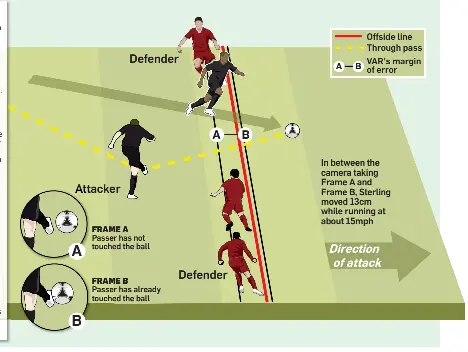USING the tight offside given against Raheem Sterling last weekend as an example, it can be shown how VAR has a margin of error that means officials sometimes cannot be certain 1 if someone is offside.

Imaging software showed Sterling to be 2.4cm offside ( just under an inch). Sterling was moving at about 14.5mph (23.4kph). Cameras used by VAR run at 50 frames per second. In the 0.02 secs between frames, he would move 13cm. If he was 2.4cm offside at Frame B that means he was 10.6cm onside at Frame A when the 2 ball was about to be played.
VAR has to use the frame which shows the ball has categorically been played but the exact ‘first point of contact’ is likely to have been between Frame A and Frame B. At an unknown point between those frames, Sterling went from 3 onside to offside.
VAR cannot have known for certain when the ball was played so there is a 13cm margin of error on a decision which ruled Sterling 2.4cm offside. It could be bigger than that too. The faster players move in opposite directions, the larger the margin of error.
The Mail on Sunday 18/08/2019
via https://www.pressreader.com/